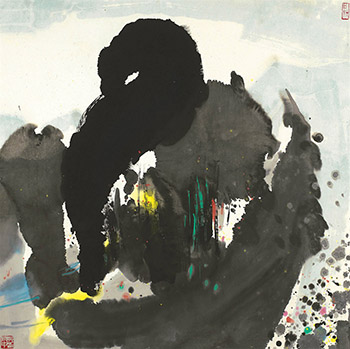EXHIBITED :
In memory of Wu Guanzhong: A Retrospective Exhibition of Wu Guanzhong’s MostSignificant Artworks, Poly Art Museum,Aug. 30 - Sep. 6, 2010
ILLUSTRATED :
The Artistic Works of Wu Guanzhong, Hebei Fine Arts publishing House, Hebei, 1984,color illustrated, p. 55
Contemporary Masters of Chinese Painting Wu Guanzhong, Shibuyaseibu Dept. store,1988, color illustrated, p. 33
The Endless Artistic Journey, Plum Blossoms Gallery, 1990,color illustrated, p. 49
In memory of Wu Guanzhong: A Retrospective Exhibition of Wu Guanzhong’s MostSignificant Artworks, Poly Art Museum, 2010, color illustrated, pp. 76-77
Catalogue Note:
“brush and ink are almost entirely valueless once viewed in isolation from that which they embody.”
As an artist who began his career with oil painting and studied for numerous years in 1940s Paris, Wu Guanzhong had always enjoyed great renowned for his sophisticated oil painting skills and modern aestheticism. Nevertheless, ever present in his mind were the profound influences of Chinese culture and the knowledge of ink painting he had acquired during his youth. These two elements deeply affected his principles of thought and conduct and even the direction of his artistic creation, especially during the late 1970s when he shifted his focus to ink painting and attained another pinnacle in his illustrious artistic career. His style of painting ink and color on paper cannot be attributed to the teachings of any particular mainstream school. Instead, Wu combined and refined the aesthetic systems of both Chinese and the Western to form a truly unique approach that reflects the world he lived in with a sheer distinctiveness elegance that simply defies imitation.
“A Heap of Stones” is an artwork of grandeur and vigor created by Wu Guanzhong in 1982 and which fully embodies the progression of his artistic career in the 1980s. During this period, Wu began employing the splash-ink freehand style and experiencing the joy and exhilaration of traditional Chinese brushwork. This resonates with the blossoming of postwar Western abstract expressionism, particularly the automatism of the drip technique. Composed of several large and heavy lumps of ink, “A Heap of Stones” encapsulates the majestic peaks of a fantasy realm manifested through solid swirls, powerful splashes and textured layering. Encircled by large masses of ink, a cavern seems to be formulated in the center from which emits the delicate luster of red, yellow and blue. The varying strokes appear to be free and spontaneous yet culminate in a compelling, vibrant dynamism that seems to penetrate and resonate throughout the vast, boundless space. The cluster of ink and color dots on the lower right of the painting bears high resemblance to jagged rocks piercing through swashing clouds. Underneath the clear blue sky, the entire mountain, unblemished and aloof, stands erectly in majestic exaltation.
This marvelous piece manifests the landscape within the artist’s mind. Instead of using traditional layouts that create depth through backdrop and foreground or brushwork composition, the artist employed heavy ink by swirling it through the space of void and landing it upon the paper in effortless abstraction, epitomizing Wu’s notable conviction that “brush and ink are valueless.” Wu proposed the concept in the 1990s under the belief that, “brush and ink are almost entirely valueless once viewed in isolation from that which they embody.” His viewpoint may have sparked wide discussions in the Chinese art scene, but is moreover an indication of the remarkable level of transcendence that this accomplished artist, who had striven to incorporate both Western and Chinese cultures, had achieved within the realm of artistic creation. Wu may have abandoned the techniques of traditional brushwork from Chinese calligraphy, yet he inherited the freehand style that emphasizes the spirituality and intrinsic beauty of ink wash. He may have broken away from the principle of perspective in traditional Western art, yet he continued to explore and pursue the beauty of form. Ink wash, for Wu, was not a system of tradition he tried to become incorporated into but a medium he wielded to convey his artistic ideals and even the spirit of life and the vocabulary with which he forged the artistic context of his contemporary epoch. Liberated from the shackles of tradition, “A Heap of Stones” is represented through galloping, unrestrained brush strokes, by turns serene or frenetic, which exemplify the artist’s brushwork technique of spontaneity and sophistication.
As awe-inspiring and majestic as the mountain scene appears, “A Heap of Stones” still embodies a poetic transcendence that is perhaps the most alluring quality of all artworks, no matter oil or ink, Wu had created over the course of his long, remarkable career. Born and bred with a graceful Jiangnan aesthetic, the artist’s aura of brilliance and clarity is the defining feature of his creations. Wu once said, “Black, white and gray are the colors of Jiangnan, the inspiration for my silvery gray palette, the point of departure of my artistic career. All my life, Jiangnan has been ever present throughout all of my paintings…” Wu studied in France in his thirties, returned to China in 1950 and resided in Beijing until the day of his passing. Although sixty years of his life were spent in the North, the majestic landscape and humanistic spirit of Jiangnan continued to nourish his artistic soul while his graceful and flowing brushstrokes not only mark his inheritance of Chinese literati culture but exemplify the spirit of contemporary ink painting, of which he is both a shaping force and an enduring influence.
